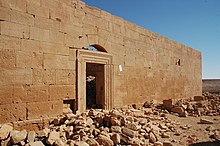 | |
| Location | Libya |
|---|---|
| Coordinates | 31°27′43″N 14°42′16″E / 31.461833°N 14.704528°E |
| Type | Fort |
| History | |
| Periods | Ancient Rome |
| Site notes | |
| Archaeologists | Graeme Barker |

Gasr Banat or Gasr Isawi is an archaeological site near Bani Walid in Libya [1] and the location of an Ancient Roman centenarium or "perched" oppidum. The area is also used as a semi-permanent camp for nomads. [2] [3] [4] It was studied by Graeme Barker in 1984. [5] Evidence from pottery found around the site suggests the date of construction was in the third century CE. [2]
The centenarium has a striking resemblance to one in Gherait esh-Shergia north of Wadi Nefud. There is an ancient temple-type mausoleum dating to the same period as the centenarium in the valley, which contains a burial chamber decorated with fish. There are also remains of a Roman quarry and dams in the nearby wadi. [6]
This particular centenarium was used frequently for several centuries. Around this centenarium there were medieval walls of old building that surrounded the building and were demolished due to natural or war related circumstances. However, regardless of the fallen walls the centenarium remained to be in a fairly good condition. [7]
References
- ^ Musso, Luisa (November 2017). "Libyan cultural heritage in danger: the museums of Tripolitania". Libyan Studies. 48: 125–133. doi: 10.1017/lis.2017.4. ISSN 0263-7189.
- ^ a b David Mattingly (5 February 1995). Tripolitania. Psychology Press. pp. 10–. ISBN 978-0-7134-5742-1. Retrieved 31 October 2012.
- ^ Graeme Barker; Barri Jones (1982). The UNESCO Libyan valleys survey 1979-1981: palaeoeconomy and environmental archaeology in the pre-desert. Society for Libyan Studies. ISBN 978-0-9508363-0-0. Retrieved 31 October 2012.
- ^ Graeme Barker; Unesco Libyan Valleys Archaeological Survey (1996). Farming the Desert: Synthesis. UNESCO. Retrieved 31 October 2012.
- ^ Libyan Studies: Annual Report of the Society for Libyan Studies. The Society. 1986. Retrieved 31 October 2012.
- ^ Erwin Ruprechtsberger, Die römische Limeszone in Tripolitanien und der Kyrenaika, Tunesien - Libyen (1993 Aalen; Limes Museum)
- ^ "Qasr Banat (Qasr Isawi) - Livius". www.livius.org. Retrieved 2021-09-16.
External links
 | |
| Location | Libya |
|---|---|
| Coordinates | 31°27′43″N 14°42′16″E / 31.461833°N 14.704528°E |
| Type | Fort |
| History | |
| Periods | Ancient Rome |
| Site notes | |
| Archaeologists | Graeme Barker |

Gasr Banat or Gasr Isawi is an archaeological site near Bani Walid in Libya [1] and the location of an Ancient Roman centenarium or "perched" oppidum. The area is also used as a semi-permanent camp for nomads. [2] [3] [4] It was studied by Graeme Barker in 1984. [5] Evidence from pottery found around the site suggests the date of construction was in the third century CE. [2]
The centenarium has a striking resemblance to one in Gherait esh-Shergia north of Wadi Nefud. There is an ancient temple-type mausoleum dating to the same period as the centenarium in the valley, which contains a burial chamber decorated with fish. There are also remains of a Roman quarry and dams in the nearby wadi. [6]
This particular centenarium was used frequently for several centuries. Around this centenarium there were medieval walls of old building that surrounded the building and were demolished due to natural or war related circumstances. However, regardless of the fallen walls the centenarium remained to be in a fairly good condition. [7]
References
- ^ Musso, Luisa (November 2017). "Libyan cultural heritage in danger: the museums of Tripolitania". Libyan Studies. 48: 125–133. doi: 10.1017/lis.2017.4. ISSN 0263-7189.
- ^ a b David Mattingly (5 February 1995). Tripolitania. Psychology Press. pp. 10–. ISBN 978-0-7134-5742-1. Retrieved 31 October 2012.
- ^ Graeme Barker; Barri Jones (1982). The UNESCO Libyan valleys survey 1979-1981: palaeoeconomy and environmental archaeology in the pre-desert. Society for Libyan Studies. ISBN 978-0-9508363-0-0. Retrieved 31 October 2012.
- ^ Graeme Barker; Unesco Libyan Valleys Archaeological Survey (1996). Farming the Desert: Synthesis. UNESCO. Retrieved 31 October 2012.
- ^ Libyan Studies: Annual Report of the Society for Libyan Studies. The Society. 1986. Retrieved 31 October 2012.
- ^ Erwin Ruprechtsberger, Die römische Limeszone in Tripolitanien und der Kyrenaika, Tunesien - Libyen (1993 Aalen; Limes Museum)
- ^ "Qasr Banat (Qasr Isawi) - Livius". www.livius.org. Retrieved 2021-09-16.
External links
